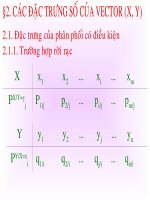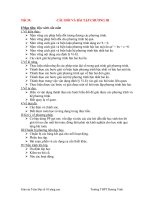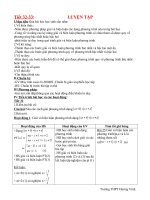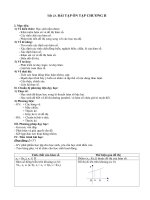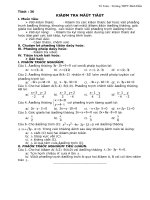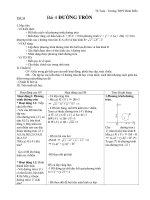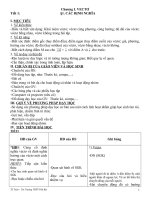Giao an 11cb(tiet45-48)
Bạn đang xem bản rút gọn của tài liệu. Xem và tải ngay bản đầy đủ của tài liệu tại đây (135.76 KB, 9 trang )
LESSON PLANS OF GRADE 11
Date: October 20
th
, 2008.
Period 45.
UNIT 7 : WORLD POPULATION
Lesson 4 : Writing
I. Objectives:
By the end of the lesson, students will be able to read and describe the
information in a chart.
II. Teaching aids:
Textbook, chalks, boards, papers,…
III. Procedure:
1. Checking students’ attendance.
2. New lesson: Unit 7_ Writing.
Stages / timing Teacher’s activities Students’ activities
Pre-writing
(20’)
Warm-up:
_ Ask ss to tell the problems and the solutions of
the population explosion.
_ Give feedback.
Lead-in:
* According to you, which continent has the
largest population and which one has the smallest
population?
Introduction:
_ In order to know about the distribution of world
population by region. Let’s study the chart on
page 86 carefully, then write a paragraph of 100-
120 words, describing the information in the
chart.
_ Ask ss to look at the chart ( page 86 ) carefully,
and answer the questions :
1. What is the topic of the chart?
2. How many regions are there ?
3. Which continent has the largest population?
4. Which one has the smallest population?
5. Is the population of Europe larger or smaller
than Africa?
_ Check ss’ answers and give feedback.
Suggested answers:
_ Give instructions to help ss do the task of
writing.
_ Talk about the problems and give out
the solutions.
_ Listen and take notes.
_ Remember the task.
_ Look at the chart and discuss to
answer the questions in pairs.
_ Listen to teacher and take notes for
the answers.
_ Listen and look at the useful
language in the textbook.
Presented by Khưu Chí Thành Thoi Quan High School
1. It’s “The distribution of world population.”
2. There are seven regions.
3. South Asia.
4. Occeania.
5. Larger.
LESSON PLANS OF GRADE 11
While-writing
(15’)
Post-writing
(9’)
Homework:
( 1’ )
1. Instructions:
Tell the chart about ( time, location, things that is
described in the chart. For exxample, the chart
shows the distribution of world population by
regions . . .
2. Body:
_ Begin with a sentence to sum up the overall
trend. For example, Generally, the world
population is distributed univenly through
regions.
_ Describe the chart in details (in a logical order).
For example, in the example above, the regions
are presented according to the percentage of the
population. Asia is ranked first because it has the
largest percentage, and South America is ranked
last because it has the smallest percentage.
3. Conclusion:
_Summarize the main point.
_ Ask ss to write a paragraph based on the outline
and the useful language.
_ Go around the class to give some helps if
necessary.
_ Check ss’ writing by reading or showing on the
board. Then give corrections.
_ Give feedback.
_ Rewrite the paragraph from the lesson that
students have learnt.
_ Prepare the part of Language focus for the next
lesson.
_ Take note for the example.
_ Discuss the task in pairs.
_ Read the useful language and discuss
to do the task in groups of four.
_ The representative from some groups
read aloud their writing to class or
showing the writing on the board.
_ Listen to teacher’s feedback. Take
corrections.
_ Listen and remember the task.
Date: October 24
th
, 2008.
Presented by Khưu Chí Thành Thoi Quan High School
LESSON PLANS OF GRADE 11
Period 46.
UNIT 7 : WORLD POPULATION
Lesson 5 : Language Focus
I. Objectives:
By the end of the lesson, students will be able to:
_ distinguish the sounds / kl / , / gl / , / gr /, and / kw /
_ pronounce the words and sentences with the sounds above.
_ use conditional type 1, 2 , and 3; and conditional in reported speech appropriately.
II. Teaching aids:
Textbook, chalks, boards, . . .
III. Procedure:
1. Checking students’ attendance.
2. Check ss’ writing.
3. New lesson: Unit 7_ Language Focus..
Stages / timing Teacher’s activities Students’ activities
Warm-up:
( 5’ )
Pronunciation
( 7’ )
Grammar
( 32’ )
_ Divide the whole class into two groups.
_ Deliver each group four pieces of paper. Each
one contains a half sentence, using conditional
sentences.
_ Ask group 1 to read aloud the first half
sentence, and group 2 have to find out the most
suitable half to combine with the first one from
group1.
Examples:
Group1 If I have lots of money, . . .
Group2 I’ll build a new house for myself.
_ Check ss’ activity, and give feedback.
* Introduction:
_ Expain how to pronounce the sounds of the
lesson.
_ Ask ss to listen to the sounds, then repeat all
the words given.
_ Ask ss to practise reading the sentences, then
read those ones in front of the class.
_ Listen and check ss’ mistakes in pronunciation.
* Revision:
Conditional sentence type 1, type 2 and type 3.
Examples:
+ If it rains, I will stay at home. ( type 1 )
( If clause ) ( main clause )
+ If I were you , I would help him. ( type 2 )
+ If you had come to the party, you would have
met our old teacher. ( type 3 )
_ Ask ss to look at the table of conditional forms.
Type If clause Main clause
I Simple will/can/shall/
_ Listen to teacher’s instruction.
_ Do the activity in two groups.
_ Listen and remember.
_ Listen and repeat the words.
_ Practice reading the sentences. Then
read the ones aloud in front of the
class.
_ Listen to teacher, and take notes.
_ Follow the examlpes and remember
how to use the grammar points.
Presented by Khưu Chí Thành Thoi Quan High School
LESSON PLANS OF GRADE 11
( Real ) present may + V.
II
(Unreal in
present)
Simple past Would/could/
Should/might/
+ V.
III
( Unreal in
the past )
Past perfect Would/could/
Should + have
+ V
3/ed
_ Ask ss to do Exercise 1 and 2 in pairs.
_ Xheck ss’ answers after they finished their task.
_ Give corrections. Then show the keys.
Answer keys of Exercise 1:
1. would drive 4. will take
2. could 5. closed
3. is 6. I’ll / will come
Answer keys of Exercise 2:
1. had been told
2. had realised
3. wouldn’t have been
4. would have bought
5. had studied.
* Introduction:
_ Give some examples:
a. “ If it rains, I’ll stay at home.” He said.
He said (that) if it rained he would stay at
home.
b. “ If I had a motorbike, I would drive it to
school.” Minh said.
Minh said (that) if he had a motorbike he
would drive it to school.
c. “ If we had studied hard, we wouldn’t have
failed the exam.” They told me.
They told me that if they had studied hard they
wouldn’t have failed the exam.
_ Ask ss to do the exercise 3 in pairs.
_ Check ss’ sentences that they have done for the
exercise.
_ Give corrections.
Suggested answers:
1. The man told her that he would come to see
her if he had time.
2. He asked her what she would say if someone
stopped on her feet.
3. They told me that if it didn’t rain, they would
go out for dinner.
4. The man asked the woman what she would do
if she were a billionaire.
5. The man told me that if I had asked him, he
would have lent me his motorbike.
_ Take notes from the table.
_ Discuss in pairs to do the exercise 1
and 2.
_ Share the answers each other.
_ Give the answers to class.
_ Correct mistakes and copy down the
true answer keys on notebook.
_ Listen to teacher and remember how
to use reported speech with conditional
sentences.
_ Discuss to do the exercise in pairs.
_ Share the answers together.
_ Show the answers to class.
_ Look at the correct answers and copy
down the true sentences.
Presented by Khưu Chí Thành Thoi Quan High School
LESSON PLANS OF GRADE 11
Homework
( 1’ )
6. The man told his daughter that they would be
very disappointed if she did not come.
7. The boy told the girl that he was sure they
wouldunderstand if she explained the situation to
them.
_ Ask ss to remember how to use the grammar
points in the lesson.
_ Do all the exercises again at home.
_ Practise reading he sounds from the lesson with
the words and the sentences.
_ Listen and remember the tasks.
Date: October 25
th
, 2008.
Period 47.
Presented by Khưu Chí Thành Thoi Quan High School


